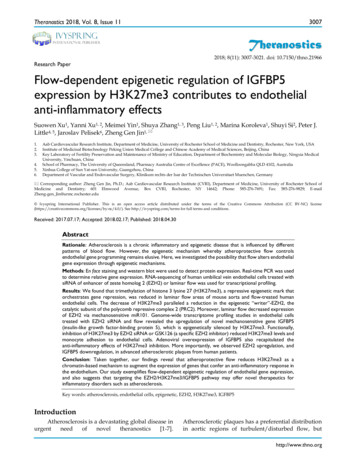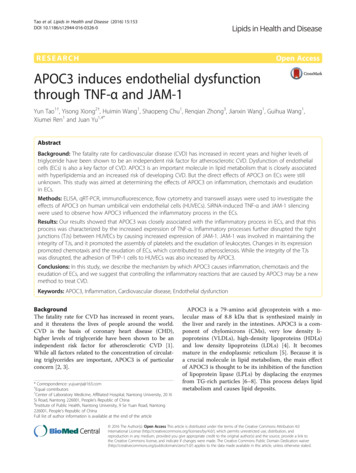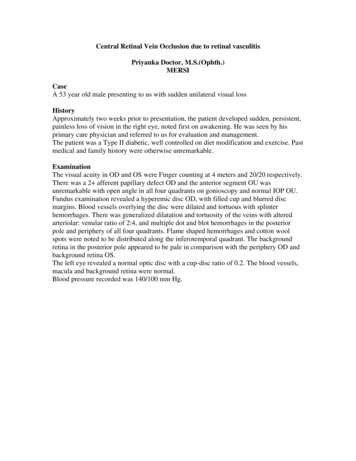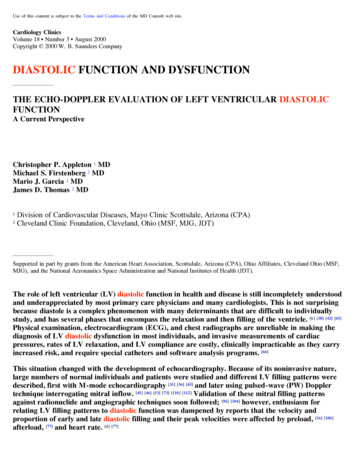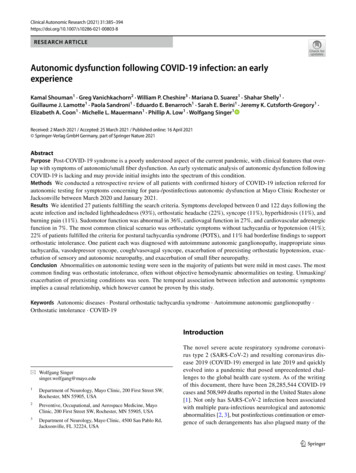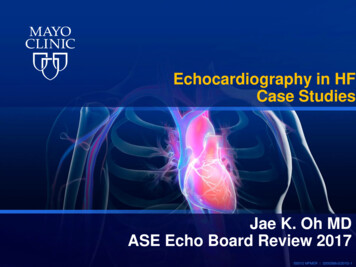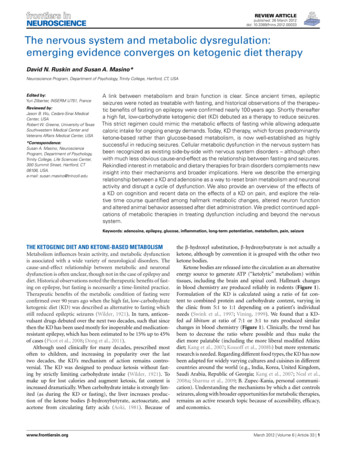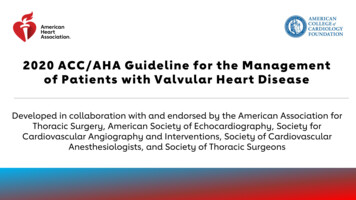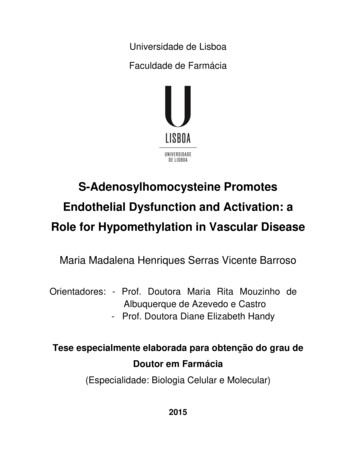
Transcription
Universidade de LisboaFaculdade de FarmáciaS-Adenosylhomocysteine PromotesEndothelial Dysfunction and Activation: aRole for Hypomethylation in Vascular DiseaseMaria Madalena Henriques Serras Vicente BarrosoOrientadores: - Prof. Doutora Maria Rita Mouzinho deAlbuquerque de Azevedo e Castro- Prof. Doutora Diane Elizabeth HandyTese especialmente elaborada para obtenção do grau deDoutor em Farmácia(Especialidade: Biologia Celular e Molecular)2015
Universidade de LisboaFaculdade de FarmáciaS-Adenosylhomocysteine PromotesEndothelial Dysfunction and Activation: aRole for Hypomethylation in Vascular DiseaseMaria Madalena Henriques Serras Vicente BarrosoOrientadores:- Prof. Doutora Maria Rita Mouzinho de Albuquerque deAzevedo e Castro- Prof. Doutora Diane Elizabeth HandyTese especialmente elaborada para obtenção do grau deDoutor em Farmácia(Especialidade: Biologia Celular e Molecular)Júri:Presidente: Prof. Doutora Cecília Maria Pereira RodriguesVogais:- Prof. Doutor Joseph Loscalzo- Prof. Doutora Diane E. Handy- Prof. Doutor João António Nave Laranjinha- Prof. Doutora Paula Alexandra Quintela Videira- Prof. Doutor Luís Afonso Brás Simões do Rosário- Prof. Doutora Maria Isabel Ginestal Tavares de Almeida- Prof. Doutora Maria Rita Mouzinho de Albuquerque de Azevedo e Castro2015
Universidade de LisboaFaculdade de FarmáciaS-Adenosylhomocysteine PromotesEndothelial Dysfunction and Activation: aRole for Hypomethylation in Vascular DiseaseS-Adenosilhomocisteína Promove Disfunção eAtivação Endotelial: um Papel para aHipometilação na Doença VascularTese especialmente elaborada para obtenção do grau deDoutor em Farmácia(Especialidade: Biologia Celular e Molecular)2015
The studies presented in this thesis were performed at the Metabolism and GeneticsGroup, The Research Institute for Medicines (iMed.ULisboa), and at the Department ofBiochemistry and Human Biology, Faculdade de Farmácia da Universidade de Lisboa,Portugal, under the supervision of Professor Rita Azevedo e Castro, and at theCardiovascular Division, Department of Medicine, Brigham and Women’s Hospital andHarvard Medical School, Harvard University, Boston, USA, under the supervision ofProfessor Diane E. Handy. This work was financially supported by Fundação para aCiência e a Tecnologia (F.C.T.), Lisboa, Portugal (SFRH/BD/73021/2010).
Para os meus pais
TABLE OF r 1General Introduction1Chapter 2Aims and Outline27Chapter 3Cellular Hypomethylation is Associated with Impaired Nitric Oxide Production31by Cultured Human Endothelial CellsChapter sEndothelial47Cell Activation by Suppressing Glutathione Peroxidase-1 Expression4.2. S-Adenosylhomocysteine Alters Methylation of Cellular RNA75Chapter 5The Role of DNA Hypomethylation in S-Adenosylhomocysteine-Induced95Endothelial ActivationChapter 6S-Adenosylhomocysteine Induces Inflammation Through NFkB: a Possible107Role for EZH2 in Endothelial Cell ActivationChapter 7General Discussion and Perspectives129List of i
Aadenosine-2’,3’-dialdehydeAdCtrlcontrol adenoviral vectorAdGPx-1adenoviral construct with the human glutathione peroxidase-1 cDNAAdIkBDNadenovirus carrying the dominant negative IkBADMAasymmetric dimethylarginineAd-βGaladenoviral construct with a CMV-LacZ cassetteALKBH8alkylation repair homolog 8Am2′-O-methyladenosineATPadenosine triphosphateBHMTbetaine-homocysteine methyltransferaseBNIP3BCL2/adenovirus E1B 19kDa interacting protein 3CBScystathionine β-synthaseCDKN1Acyclin-dependent kinase inhibitor 1ACDKN2Acyclin-dependent kinase inhibitor 2ACGLcystathionine γ-lyaseCm2′-O-methylcytidine5cm r c acid)DTTdithiothreitoleNOSendothelial nitric oxide synthaseEZH2enhancer of zeste homolog 2FoxO1forkhead box O 1Gm2′-O-methylguanosineGPx1glutathione peroxidase-1GRPglucose-regulated proteinix
AbbreviationsH2O2hydrogen peroxideH3K9me3histone H3 lysine 9 trimethylationH3K27me3histone H3 lysine 27 trimethylationHCAEChuman coronary artery endothelial cellsHcyhomocysteineHDMhistone demethylaseHHcyhyperhomocysteinemiaHKMThistone lysine methyltransferaseHUVEChuman umbilical vein endothelial cellsi6AisopentenyladenosineICAM-1intercellular adhesion molecule-1IkBinhibitor of kappa BIkBDNinhibitor of kappa B dominant negative mutantIKKIκB kinase complexILinterleukinJMJD3jumonji domain containing 3 demethylaseLC-MS/MSliquid chromatography-tandem mass spectrometryLDHlactate dehydrogenaseLDLlow-density lipoproteinLDLRlow-density lipoprotein methionine 5mcm ean fluorescence intensityMSmethionine synthaseMsrB1methionine sulfoxide reductase B1MTHFR5,10-methylenetetrahydrofolate reductasemcm Ux
iphenyltetrazolium bromideNACN-acetylcysteineNFκBnuclear factor kappa BNIKNFkB-interacting kinaseNOnitric oxideNOXNADPH oxidaseNTno treatmentPBSphosphate-buffered salinePDGFplatelet-derived growth factorPECAM-1platelet endothelial cell adhesion molecule-1PKCprotein kinase CPRCpolycomb repressive complexPRMT1protein arginine methyltransferase-1qRT-PCRquantitative reverse transcription polymerase chain reactionROSreactive oxygen cysteine ELEE-selectin coding geneSelHselenoprotein HSelMselenoprotein MShcSrc homology 2 domain containingSHMTserine hydroxymethyltransferasesiRNAsmall interference RNASODsuperoxide dismutaseSREBF1sterol regulatory element binding transcription factor-1TETten-eleven translocation enzymesTHFtetrahydrofolateTNFtumor necrosis factorTRM112[Ser]SectRNA methyltransferase 112 homologtRNAselenocysteine-carrying tRNA (Sec-tRNA)TrxRthioredoxin reductaseUm2′-O-methyluridineUPRunfolded protein responsexi
AbbreviationsUTXubiquitously transcribed tetratricopeptide repeat on X chromosomedemethylaseVCAM-1vascular adhesion molecule-1WBCwhite blood cellsxii
SummarySUMMARYHomocysteine has been established as a risk factor for cardiovascular disease (CVD) bymechanisms incompletely defined. S-Adenosylhomocysteine (SAH) is the metabolic precursor ofhomocysteine that accumulates in the setting of hyperhomocysteinemia and is a negative regulator ofmost cell methyltransferases.This thesis project investigated whether methylation imbalance, caused by excess SAH,disrupts endothelium homeostasis and favors the establishment of a pro-atherogenic phenotype.To experimentally address this possibility, studies were conducted in human endothelial cells,in which SAH accumulation was induced using either a pharmacologic or a siRNA approach. As themajor regulator of vascular homeostasis, the endothelium exerts a number of vasoprotective effectsthat are largely mediated by nitric oxide (NO), the most potent endogenous vasodilator. DecreasedNO bioavailability is a principal manifestation of underlying endothelial dysfunction, an early marker ofatherosclerosis and CVD. To determine whether excess SAH alters NO bioavailability, the expressionand activity of endothelial nitric oxide synthase (eNOS), and NO production were monitored in cells.These experiments showed that excess SAH increased the levels of eNOS mRNA but caused adecrease in eNOS protein and activity, to decrease cellular production of NO.Another important feature of endothelial dysfunction is oxidative stress. Studies in endothelialcells revealed that a hypomethylating environment, induced by excess SAH, impairs, not only NOproduction, but also the cellular redox state. Glutathione peroxidase-1 (GPx-1) is a selenoprotein anda major cellular antioxidant. A link between homocysteine-associated suppression of GPx-1 andendothelial dysfunction had been reported previously; however, the causal molecular mechanismsremained unresolved. The experiments presented here demonstrate a specific mechanism by whichSAH-mediated hypomethylation suppresses GPx-1 expression and leads to inflammatory activation ofendothelial cells. The expression of a subset of selenoproteins (including GPx-1) is dependent on aspecific methylation of the selenocysteine-tRNA (Sec-tRNA). Thus, SAH accumulation was found toinhibit the formation of this methylated isoform of Sec-tRNA resulting in decreased GPx-1 expression,as well as alterations in the expression of other selenoproteins, to promote oxidative stress and apro-inflammatory activation state in endothelial cells.The observation that Sec-tRNA methylation is decreased by excess SAH, suggests that otherRNA species may also be targets for SAH-mediated hypomethylation. Therefore, the effect of SAH onmethylation modifications was determined in total and size-fractionated RNA samples from our cellmodel. Additionally, to confirm these observations, RNA methylation was analyzed in tissue samplesfrom a hyperhomocysteinemic mouse model, where SAH accumulation results from a geneticdisorder affecting homocysteine metabolism. Conditions of excess SAH altered the content of somexiii
SummaryRNA methylation modifications, suggesting that specific RNA methyltransferases may be moresusceptible to inhibition by SAH.The activation of endothelial cells that occurs during atherogenesis is characterized by theup-regulation of adhesion molecules, which by recruiting circulating leukocytes favor theirtransendothelial migration. In a series of studies, the physiological relevance of SAH-inducedendothelial cell activation was demonstrated by determining that these SAH-activated cells promotedleukocyte adhesion and migration. Further, the role of DNA hypomethylation on the SAH-inducedup-regulation of adhesion molecules was examined. ICAM-1 (intercellular adhesion molecule 1) wasfound to be up-regulated by SAH accumulation as well as by a DNA methyltransferase inhibitor,suggesting that its expression may be regulated by DNA methylation.Analysis of its promotermethylation; however, showed that it was demethylated in untreated cells, suggesting that it may beregulated by factors other than DNA promoter methylation in response to excess SAH.To understand better the factors involved in the pro-inflammatory activation of endothelialcells, the role of NFkB (nuclear factor kappa B) in SAH-induced responses was examined. Thesestudies establish a role for NFkB in the endothelial cell response to SAH and further link theseresponses to a suppression of the epigenetic regulator EZH2 (enhancer of zeste homolog 2). EZH2is a methyltransferase that regulates gene expression by mediating a repressive histone methylation.These results identify EZH2 as a new target of SAH regulation important in inflammatory responses,demonstrating that EZH2 suppression and NFkB activation mediated by excess SAH accumulationmay contribute to its adverse effects in the vasculature.Overall, these studies implicate SAH as a key modulator of epigenetic mechanisms bycompromising RNA, DNA, and histone methylation. More importantly, our results clearly present SAHas a key player in the disruption of endothelial homeostasis, supporting a role for SAH as animportant mediator of homocysteine-associated vascular disease.Key words: S-Adenosylhomocysteine, hyperhomocysteinemia, hypomethylation stress, endothelialdysfunction, pro-inflammatory phenotype.xiv
SumárioSUMÁRIOA doença cardiovascular é a principal causa de morte nos países desenvolvidos, facto quereflete a insuficiência das atuais medidas terapêuticas e de prevenção para esta patologia.O aumento do conhecimento sobre os mecanismos moleculares na origem da doença cardiovascularpoderá assim contribuir para a resolução deste importante problema de saúde pública. A elevaçãodos níveis circulantes de homocisteína é um fator de risco para a ocorrência de doençacardiovascular; no entanto, os mecanismos fisiopatológicos subjacentes à relação entre ahiperhomocisteinémia e a doença cardiovascular, embora intensamente estudados, permanecemainda por elucidar.A homocisteína é um aminoácido sulfurado, em cujo metabolismo as vitaminas do grupo Batuam como importantes cofatores ou substratos. Em estudos clínicos, nos quais a concentração dehomocisteína plasmática foi significativamente reduzida através da administração destas vitaminas,não foram observados os efeitos cardio-protetores esperados. Uma teoria alternativa propõe aS-adenosilhomocisteína (SAH), o precursor metabólico da homocisteína que se acumula emsituações em que esta se encontra elevada, como um marcador mais fidedigno do risco de doençacardiovascular associado a situações de hiperhomocisteinémia. Sendo a SAH um regulador negativoda atividade enzimática da maioria das metiltransferases celulares, que atuam sobre diversoscompostos (incluindo moléculas como DNA, RNA e proteínas), a sua acumulação poderá originar,teoricamente, um ambiente celular de hipometilação.A presente tese investigou a possibilidade de o desequilíbrio das reações de metilaçãocelulares, provocado pela elevação dos níveis intracelulares de SAH, perturbar a homeostaseendotelial, favorecendo o estabelecimento de um fenótipo pró-aterogénico e a ocorrência de doençacardiovascular. Para tal, desenvolveu-se um modelo de estudo com base em células endoteliaishumanas, nas quais a acumulação de SAH foi induzida através de abordagens genéticas (RNA deinterferência) ou farmacológicas (inibição da atividade da enzima responsável pela síntese de SAH,a SAH hidrolase).O endotélio é o principal regulador da homeostasia vascular, exercendo uma série de efeitosvasoprotetores que são largamente mediados pelo óxido nítrico (NO), um potente vasodilatadorendógeno. A diminuição da biodisponibilidade do NO é uma manifestação importante da disfunçãoendotelial e um marcador precoce de aterosclerose e doença cardiovascular. O trabalhoexperimental desenvolvido revelou que o excesso de SAH diminui os níveis endoteliais de NO, osquais estão diretamente relacionados com a diminuição, quer dos níveis de proteína eNOS (sintasedo óxido nítrico endotelial), quer da sua atividade enzimática.Outra característica importante da disfunção endotelial é um aumento de stress oxidativo.Várias selenoproteínas, incluindo a glutationa peroxidase-1 (GPx-1), são componentes enzimáticosxv
Sumáriodos principais sistemas antioxidantes celulares. Estudos anteriores relataram a existência de umaassociação entre a supressão de GPx-1, induzida por um excesso de homocisteína, e a ocorrênciade disfunção endotelial, sem no entanto conseguir esclarecer os mecanismos molecularessubjacentes. Adicionalmente, encontra-se descrito que a expressão de um subconjunto deselenoproteínas, entre as quais a GPx-1, depende da metilação específica do RNA de transferêncianecessário à incorporação do aminoácido selenocisteína (Sec-tRNA). Interessantemente, osresultados das nossas experiências revelaram que um ambiente de hipometilação, induzido por umexcesso de SAH, altera não só a produção de NO, mas também o estado redox celular.Efetivamente, as experiências aqui apresentadas demonstraram a existência de um mecanismoespecífico através do qual a hipometilação suprime a expressão de GPx-1 e leva à ativaçãoinflamatória das células endoteliais. Os resultados revelaram que a acumulação de SAH inibe aformação da isoforma metilada do Sec-tRNA, o que resulta na diminuição da expressão da GPx-1,bem como em alterações na expressão de outras selenoproteínas, promovendo, desta forma, umestado de stress oxidativo e de ativação pró-inflamatória das células endoteliais.A observação de que a metilação do Sec-tRNA é reduzida por um excesso de SAH sugere apossibilidade de que outras espécies de RNA possam ser igualmente alvos da hipometilaçãomediada pela acumulação intracelular de SAH. Para averiguar esta possibilidade, foramquantificadas modificações de metilação, quer em RNA total, quer em diferentes espécies de RNAobtidas por fracionamento de acordo com o seu tamanho molecular, extraídas de amostras do nossomodelo celular. Adicionalmente, estas observações foram avaliadas em amostras de tecido obtidas apartir de um modelo animal de hiperhomocisteinémia, no qual a acumulação de SAH resulta de umadeficiência da enzima CBS (cistationina β-sintetase) envolvida no catabolismo da homocisteína. Emambas as condições estudadas, os resultados revelaram alterações nos níveis de modificações pormetilação do RNA, sugerindo que as metiltransferases específicas de RNA são suscetíveis à inibiçãoda sua atividade enzimática pela acumulação de SAH.O estado de ativação de células endoteliais que ocorre durante a aterogénese caracteriza-sepor um aumento da expressão de citocinas e moléculas de adesão, as quais recrutam leucócitoscirculantes, favorecendo a sua migração transendotelial e a formação das placas de ateroma.A relevância fisiológica da ativação endotelial induzida pela SAH foi demonstrada numa série deestudos, nos quais se observou um aumento da expressão de moléculas de adesão e um acréscimona capacidade das células endoteliais promoverem a adesão de leucócitos e a sua subsequentetransmigração.A metilação do DNA é um mecanismo epigenético que pode regular a expressão genética,estando a hipometilação das regiões promotoras tipicamente associada com a ativação da expressãodos genes correspondentes. Por esta razão, após a confirmação de que SAH induz umahipometilação global do DNA no modelo celular utilizado, foi examinado o papel desta hipometilaçãoxvi
Sumáriona sobre-expressão de moléculas de adesão. Os resultados revelaram que a expressão endotelial deICAM-1 (intercellular adhesion molecule-1), uma importante molécula de adesão, era reguladapositivamente não só por uma acumulação de SAH induzida no nosso modelo celular, mas tambémpela utilização de um inibidor específico das metiltransferases do DNA. No entanto, a quantificaçãodos níveis de metilação no promotor do gene ICAM1 revelaram um estado de hipometilação nascélulas controlo, ou seja, com níveis normais de SAH. Estes dados demonstram que a indução daexpressão de ICAM-1 por SAH é mediada por fatores independentes da hipometilação do seupromotor.Como referido, o excesso de SAH induz um fenótipo pró-inflamatório nas células endoteliais.Assim, e com o intuito de compreender melhor os mecanismos moleculares subjacentes, foramexaminadas as vias de ativação do NFkB (nuclear factor kappa B), um conhecido promotor daresposta inflamatória. Os resultados estabelecem um papel da ativação do NFkB nesta respostainflamatória, sugerindo que a supressão do regulador epigenético EZH2 (enhancer of zeste homolog2) possa contribuir para esta resposta. O EZH2 é uma histona metiltransferase que regulanegativamente a expressão genética através da metilação específica das histonas (nomeadamenteao estabelecer a trimetilação da lisina 27 na histona H3, ou seja a marca epigenética H3K27me3). Aacumulação de SAH em células endoteliais resultou numa diminuição da expressão e atividade deEZH2, que subsequentemente determinou um aumento de expressão de citocinas pro-inflamatórias emoléculas de adesão celular. Estes resultados revelaram assim um novo alvo para a SAH naregulação da resposta inflamatória endotelial, demonstrando que a supressão de EZH2 e a ativaçãode NFkB, mediadas pelo excesso de SAH, contribuem para os seus efeitos adversos no endotélio.Considerados em conjunto, estes estudos implicam a SAH como um metabolito chave namodulação de mecanismos epigenéticos, ao comprometer a metilação do DNA, do RNA e dashistonas, e mostram claramente que a acumulação de SAH desempenha um papel determinante naperturbação da homeostasia do endotélio. Como referido anteriormente, a SAH é o precursormetabólico da homocisteína. Os resultados aqui apresentados demonstram um papel importante daSAH como mediador da doença vascular associada à hiperhomocisteinémia, suportando a hipóteseda SAH ser um possível marcador mais fidedigno do que a própria homocisteína.Palavras-chave: S-adenosilhomocisteína, hiperhomocisteinémia, stress de hipometilação, disfunçãoendotelial, fenótipo pro-inflamatório.xvii
CHAPTERGeneral Introduction11. Homocysteine Metabolism2. Hyperhomocysteinemia3. Hyperhomocysteinemia and Cardiovascular Disease3.1. Homocysteine and Endothelial Dysfunction and Activation3.2. S-Adenosylhomocysteine and Cardiovascular Disease4. S-Adenosylhomocysteine and Cell Hypomethylation4.1. Targets of S-Adenosylhomocysteine-Mediated Methylation Inhibition4.1.1. DNA4.1.2. RNA4.1.3. Protein
Chapter 11. Homocysteine MetabolismHomocysteine was identified by the Nobel laureate Vincent DuVigneaud in 1932 during hispioneering studies on sulfur amino-acid chemistry. In fact, he first discovered the disulfidehomocystine, and only later identified its reduced form, an intermediate of methionine metabolism,which he named homocysteine (1).Homocysteine metabolism is shown in Figure 1. Homocysteine is formed by the demethylationof the essential amino acid, methionine, via the formation of two intermediate compounds,S-adenosylmethionine (SAM) and S-adenosylhomocysteine (SAH) (2). Methionine is first converted toSAM through the catalytic action of methionine adenosyltransferase enzymes (MATs). MAT transfersthe adenosyl moiety of ATP to the methionine molecule, forming SAM, a highly energetic compound.SAM is the major methyl-donor compound for cellular methylation reactions, which are catalyzed byspecific methyltransferases that target important biomolecules, such as DNA, RNA, proteins, andlipids (2). Nevertheless, in mammals, most methyl groups transferred from SAM are used in creatineformation, in phosphatidylcholine synthesis, and in the generation of sarcosine from glycine (3). Afterthe transfer of a methyl group, the methylated product is formed and SAM is converted to SAH.Importantly, because SAH has nearly the same, or even higher affinity for the catalytic site of mostSAM-dependent methyltransferases than SAM, SAH is a potent inhibitor of these methyltransferasesand the SAM/SAH ratio is often used as an indicator for intracellular methylation capacity (4).SAH is further converted into homocysteine and adenosine by SAH hydrolase (SAHH), whichis ubiquitously expressed in mammalian tissues. The formation of homocysteine from methionine viathe transmethylation pathway is the only pathway for homocysteine biosynthesis in humans (2).Importantly, the SAH hydrolase reaction is reversible and presents a thermodynamicequilibrium that strongly favors SAH synthesis rather than its hydrolysis (5). However, under normalphysiological conditions the reaction is directed towards SAH hydrolysis due to the rapid metabolismor export of homocysteine. Homocysteine is located at a metabolic branch point and can be eitherconserved by remethylation back to methionine or irreversibly degraded to cysteine via thetranssulfuration pathway (5).Homocysteine can be remethylated back to methionine by two alternative metabolic pathways,the folate-dependent or independent remethylation pathways (Figure 1). 5-Methyltetrahydrofolate(5-MTHF) is the active folate derivative and the main circulating form of folate in plasma. In the folatedependent-pathway, 5-MTHF supplies the methyl group used by methionine synthase (MS) toremethylate homocysteine and produce methionine and tetrahydrofolate (THF). THF is thenconverted to 5,10-methylenetetrahydrofolate (5,10-MeTHF) in the presence of serine and vitamin Afterreductionby5,10-methylenetetrahydrofolate reductase (MTHFR), 5,10-MeTHF is converted into 5-MTHF, whichwill be available for the remethylation of a second molecule of homocysteine. MTHFR uses flavin3
General Introductionadenine dinucleotide (FAD; the active form of vitamin B2) as a cofactor. The folate-dependentremethylation pathway is present in nearly all cells (3, 6).Additionally, in liver and kidney,remethylation also occurs by the folate independent pathway in which methyl groups are donated bybetaine (also known as trimethylglycine, a derivative of choline oxidation), in a reaction catalyzed bythe enzyme betaine-homocysteine methyltransferase (BHMT) (3, 6).Figure 1 - Schematic representation of homocysteine metabolism. MAT (methionineadenosyltransferase), SAHH (S-adenosylhomocysteine hydrolase), CBS (cystathionine -synthase), CGL (cystathionine γ-lyase), MS (methionine synthase), SHMT (serinehydroxymethyltransferase), MTHFR (5,10-methylenetetrahydrofolate reductase), BHMT(betaine-homocysteine methyltransferase).Homocysteine can be irreversibly metabolized through the transsulfuration pathway, which ismainly confined to the liver, kidney, small intestine and pancreas (7). In the first step of this pathway,cystathionine β-synthase (CBS) catalyzes the condensation of homocysteine and serine to formcystathionine using pyridoxal phosphate (PLP or vitamin B6) as a co-factor (5). Cystathionine isfurther metabolized to produce cysteine by another PLP-requiring enzyme, cystathionine γ-lyase(CGL) (5, 8). In addition to protein synthesis, cysteine is used in the synthesis of glutathione, animportant cellular antioxidant (5, 9). The sulfur end product of cysteine metabolism is sulfate, whichcan be excreted by the kidneys (10).In addition to the homocysteine metabolic pathways, and to maintain the optimal intracellularlevels of homocysteine, cells may also export homocysteine. The mechanisms that regulatehomocysteine export into the extracellular compartment are not completed defined. Nevertheless, twotypes of transport of homocysteine across the cell membranes were suggested: one involving the4
Chapter 1removal of the reduced form of homocysteine (with a free thiol group) to the extracellularcompartment, and the other the transport of the oxidized, disulfide forms of homocysteine, that aremost abundant in plasma, into cells (11). In plasma, the majority (98-99%) of homocysteine is rapidlyoxidized, reacting with free thiol-containing molecules (including small thiol molecules such ashomocysteine or cysteine, and proteins with free cysteines, such as albumin) to form disulfides. Theremaining 1-2% of plasma homocysteine remains in its reduced form (5, 11). Total plasmahomocysteine includes the sum of the circulating homocysteine molecules either in its reduced oroxidized forms.Homocysteine can be cleared from the organism by urinary excretion, but 98-99% of plasmahomocysteine is reabsorbed in the kidney (12). The remethylation and transsulfuration pathways playmajor roles in maintaining circulating homocysteine levels. Nevertheless, when renal function iscompromised, homocysteine levels often become elevated (5, 12).2. HyperhomocysteinemiaThe intracellular concentration of homocysteine is under tight control. Once formed in the cell,homocysteine is either metabolized to cysteine or remethylated to methionine or exported from thecell. Hence, cellular export of homocysteine reflects the balance between homocysteine productionand its catabolism. Persistent elevation of homocysteine in the blood defines the condition calledhyperhomocysteinemia. In healthy adults, fasting homocysteine concentrations in plasma are usuallywithin a 5-15 µmol/L range (13–15). Hyperhomocysteinemia is classified according to the levels erate(31-100µmol/L),orsevere ( 100 µmol/L) (14, 16, 17).Several factors can contribute to the circulating levels of homocysteine. In fact, plasmahomocysteine levels are influenced by various non-genetic as well as genetic determinants.Non-genetic determinants of plasma homocysteine include inadequate concentrations ofB vitamins that play a vital role in the metabolism of homocysteine. As mentioned in the previoussection, folate is a primary substrate for homocysteine remethylation and other B vitamins, such asvitamin B12, vitamin B6, and vitamin B2, are co-factors for the major homocysteine regulating enzymes(Figure 1). As such, plasma concentrations of homocysteine are inversely related to plasmaconcentrations of folate, vitamin B12 and vitamin B6, as well as to the intake of these vitamins (18). Themost consistent association has been found with lower folate intake or with lower plasmaconcentrations of folate (17). A modest inverse relationship has been reported between plasmaconcentrations of vitamin B2 and homocysteine; however, this association is restricted to subjectscarrying the MTHFR 677TT genotype (see below). In addition, normal kidney function maintainsoptimal plasma levels of homocysteine, and impaired renal function is often associated with mild tomoderate hyperhomocysteinemia (5, 12). Plasma homocysteine concentrations increase with age. In5
General Introductionfact, homocysteine levels approximately double from childhood to old age (2, 5). Gender alsosignificantly affects concentration of plasma homocysteine, with males having higher levels thanfemales (5, 17). A rise in plasma homocysteine concentrations with menopause has been alsodescribed (17). Lifestyle factors can also modulate the circulating levels of homocysteine. Tobaccosmoking, high coffee consumption, alcoholism, and lack of exercise are examples of lifestyle factorsassociated with mild hyperhomocysteinemia (19). Several pharmacological agents can also disturbhomocysteine metabolism, such as certain anti-carcinogenic agents (e.g. methotrexate orsulfasalazine) and anticonvulsants (e.g. carbamazepine or phenytoin) (22). Lastly, pathologicconditions, such as hypothyroidism, psoriasis, lymphoblastic
and activity of endothelial nitric oxide synthase (eNOS), and NO production were monitored in cells. These experiments showed that excess SAH increased the levels of eNOS mRNA but caused a decrease in eNOS protein and activity, to decrease cellular production of NO. Another important feature of endothelial dysfunction is oxidative stress.


